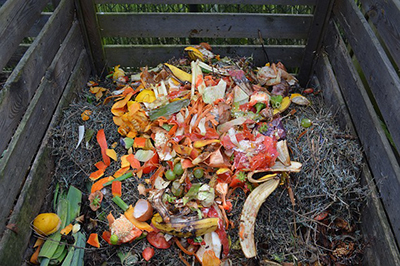OF ALL MY household chores, the yuckiest is scraping food scraps into the pail I keep under the sink. It’s always messy. Twice a week, I dump that bucket in our yard waste bin. By then, the chicken bones (some with meat still on them), brown and gooey banana peels and uneaten Thai food are smelly. And once the bin is wheeled to the curb, things are really rank.
Last week, I scraped scrambled eggs, soggy toast and an apple core into that bucket beneath our sink. As I looked at the chewed-up apple I thought: “Where will this core go?” I knew it would become compost (a mixture of decaying organic matter used as fertilizer), but how? When? And for whom?
Three days later I was at the Redwood Landfill, which is on the right as you’re about to leave Marin on Highway 101 heading north. I was talking to Alisha McCutcheon, who runs the composting program for Waste Management, the folks who operate the county dump. We were on a hillside, overlooking tall rows of recently deposited hedge clippings, leaves, weeds and, here and there, collections of rotting apples, pieces of pizza (some still in a box) and decaying bones (again, some with meat on them). I told McCutcheon that I live in Tiburon and about my apple core and she pointed at a row and said, “It could be right there, because every weekday about 300 tons of Southern and Central Marin’s and Novato’s residential green waste, including food scraps, is dumped in the Redwood Landfill.”
Within two days of being dumped, green waste and garbage (including my now-rotting apple core) are loaded into a large machine that grinds them into pieces smaller than six inches. “The grinder senses when a boulder or a lead pipe is coming through and automatically shuts down,” explains McCutcheon, “but Marin residents send us pretty clean stuff — black plastic bags are our nemesis; we pick them out by hand.”
The 10-foot-tall piles of six-inch particles then get a dousing of storm water and are left to sit, or cure, for about a month as the composting process begins. During this period the piles are aerated by air blown into them, rather than being turned over by a tractor. “This is when the compost’s temperature reaches 131 degrees Fahrenheit,” notes McCutcheon, “which destroys all the pathogens, weed seeds and pesticides in the mix.” Once this process starts, it takes 30 days for my apple core to be dissolved by bacteria, fungi and other biological means (in comparison, it takes a plastic bag 10 to 20 years, a plastic water bottle 100 years, and a hard plastic bottle cap 400 years to dissolve).
After sitting in those covered aerated static piles for a month, the green waste looks like pretty good compost, but McCutcheon isn’t satisfied. “Next, we’ll run it through a screener that only lets through particles three-eighths of an inch or smaller,” she says. “Then those piles of fine compost will sit and mature for at least 90 days.” From there, the loamy-looking material is sold in bulk to wine country vintners or put in bags that are purchased by weekend gardeners like me. (I kid you not: I used my bag of “WM EarthCare Homegrown Compost Made from 100 Percent Recycled Food Scraps and Yard Trimmings” when I planted a new honey crisp apple tree.)
When you’re composting, you’re recycling waste that would otherwise sit for years in a landfill emitting greenhouse gases. You are also saving water and power by not running your garbage disposal. In addition, compost saves additional water by retaining moisture and enriches your soil by returning nutrients to it. Some gardeners say the stuff even smells sweet. So if you’re already composting, keep on doing it; if not, it’s time to start. It’s good for your soul, as well as Planet Earth. That’s my point of view. What’s yours?
The views and opinions expressed in this article are those of the author and do not necessarily reflect the policy or position of Marin Magazine and its staff.
This article originally appeared in Marin Magazine’s print edition under the headline: “From Garbage to Garden.”


